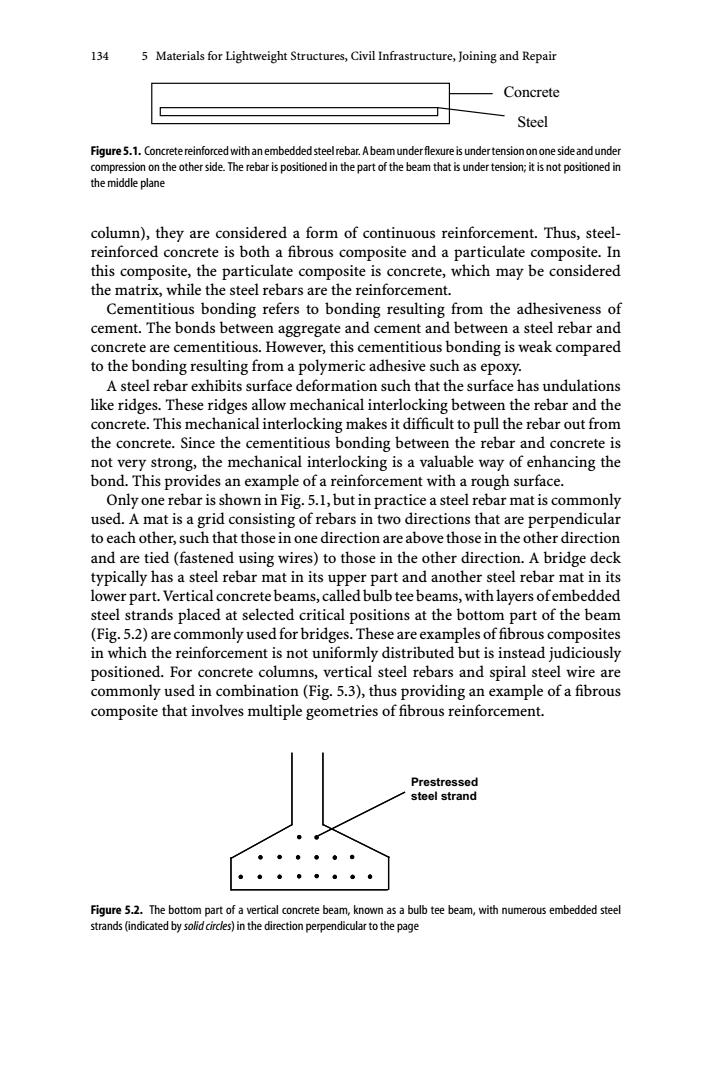正在加载图片...

134 5 Materials for Lightweight Structures,Civil Infrastructure,Joining and Repair Concrete Steel Figure5.1.Concretereinforced with anembedded steelrebar.Abeamunder flexure is undertension onone side and under compression on the other side.The rebar is positioned in the part of the beam that is under tension;it is not positioned in the middle plane column),they are considered a form of continuous reinforcement.Thus,steel- reinforced concrete is both a fibrous composite and a particulate composite.In this composite,the particulate composite is concrete,which may be considered the matrix,while the steel rebars are the reinforcement. Cementitious bonding refers to bonding resulting from the adhesiveness of cement.The bonds between aggregate and cement and between a steel rebar and concrete are cementitious.However,this cementitious bonding is weak compared to the bonding resulting from a polymeric adhesive such as epoxy. A steel rebar exhibits surface deformation such that the surface has undulations like ridges.These ridges allow mechanical interlocking between the rebar and the concrete.This mechanical interlocking makes it difficult to pull the rebar out from the concrete.Since the cementitious bonding between the rebar and concrete is not very strong,the mechanical interlocking is a valuable way of enhancing the bond.This provides an example of a reinforcement with a rough surface. Only one rebar is shown in Fig.5.1,but in practice a steel rebar mat is commonly used.A mat is a grid consisting of rebars in two directions that are perpendicular to each other,such that those in one direction are above those in the other direction and are tied (fastened using wires)to those in the other direction.A bridge deck typically has a steel rebar mat in its upper part and another steel rebar mat in its lower part.Vertical concrete beams,called bulb tee beams,with layers ofembedded steel strands placed at selected critical positions at the bottom part of the beam (Fig.5.2)are commonly used for bridges.These are examples of fibrous composites in which the reinforcement is not uniformly distributed but is instead judiciously positioned.For concrete columns,vertical steel rebars and spiral steel wire are commonly used in combination(Fig.5.3),thus providing an example of a fibrous composite that involves multiple geometries of fibrous reinforcement. Prestressed steel strand Figure 5.2.The bottom part of a vertical concrete beam,known as a bulb tee beam,with numerous embedded steel strands(indicated by solid circles)in the direction perpendicular to the page134 5 Materials for Lightweight Structures, Civil Infrastructure, Joining and Repair Steel Concrete Figure5.1. Concretereinforcedwithanembeddedsteelrebar.Abeamunderflexureisundertensionononesideandunder compression on the other side. The rebar is positioned in the part of the beam that is under tension; it is not positioned in the middle plane column), they are considered a form of continuous reinforcement. Thus, steelreinforced concrete is both a fibrous composite and a particulate composite. In this composite, the particulate composite is concrete, which may be considered the matrix, while the steel rebars are the reinforcement. Cementitious bonding refers to bonding resulting from the adhesiveness of cement. The bonds between aggregate and cement and between a steel rebar and concrete are cementitious. However, this cementitious bonding is weak compared to the bonding resulting from a polymeric adhesive such as epoxy. A steel rebar exhibits surface deformation such that the surface has undulations like ridges. These ridges allow mechanical interlocking between the rebar and the concrete. This mechanical interlocking makes it difficult to pull the rebar out from the concrete. Since the cementitious bonding between the rebar and concrete is not very strong, the mechanical interlocking is a valuable way of enhancing the bond. This provides an example of a reinforcement with a rough surface. Only one rebar is shown in Fig. 5.1, but in practice a steel rebar mat is commonly used. A mat is a grid consisting of rebars in two directions that are perpendicular to each other, such that those in one direction are above those in the other direction and are tied (fastened using wires) to those in the other direction. A bridge deck typically has a steel rebar mat in its upper part and another steel rebar mat in its lower part. Vertical concrete beams, called bulb tee beams, with layers of embedded steel strands placed at selected critical positions at the bottom part of the beam (Fig. 5.2) are commonly used for bridges. These are examples of fibrous composites in which the reinforcement is not uniformly distributed but is instead judiciously positioned. For concrete columns, vertical steel rebars and spiral steel wire are commonly used in combination (Fig. 5.3), thus providing an example of a fibrous composite that involves multiple geometries of fibrous reinforcement. Prestressed steel strand Figure 5.2. The bottom part of a vertical concrete beam, known as a bulb tee beam, with numerous embedded steel strands (indicated bysolid circles) in the direction perpendicular to the page